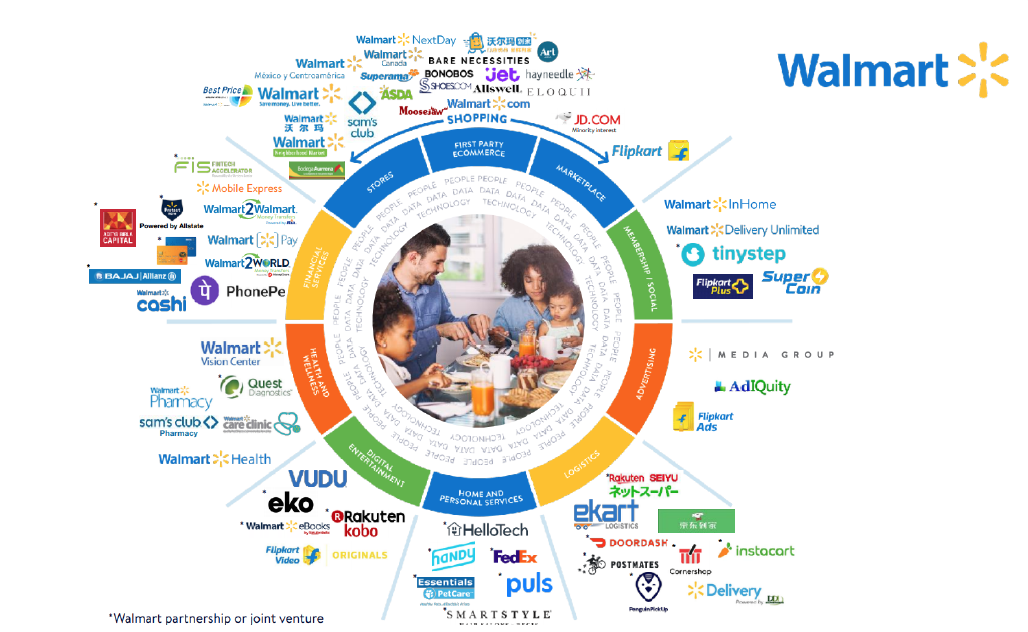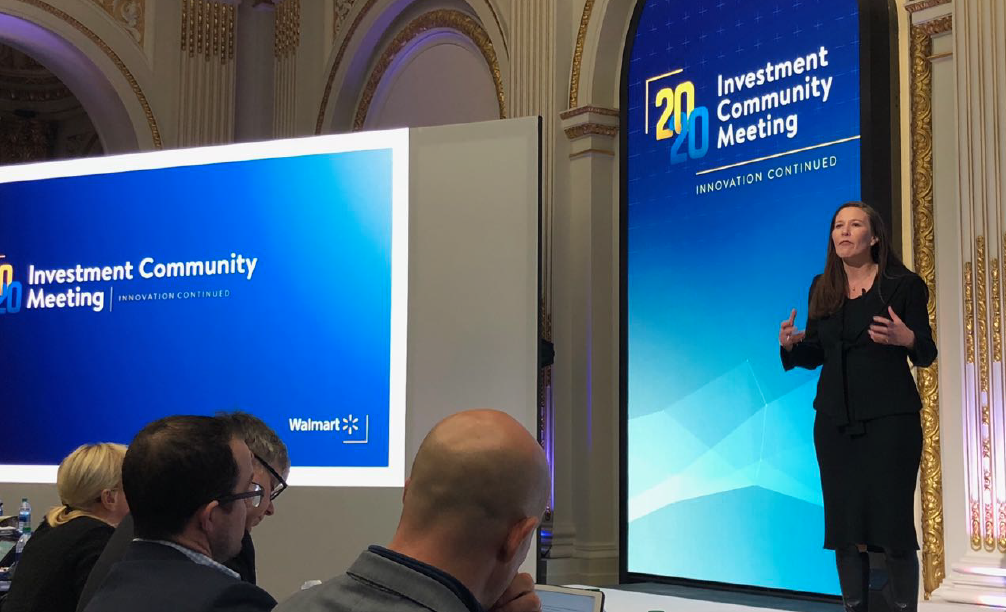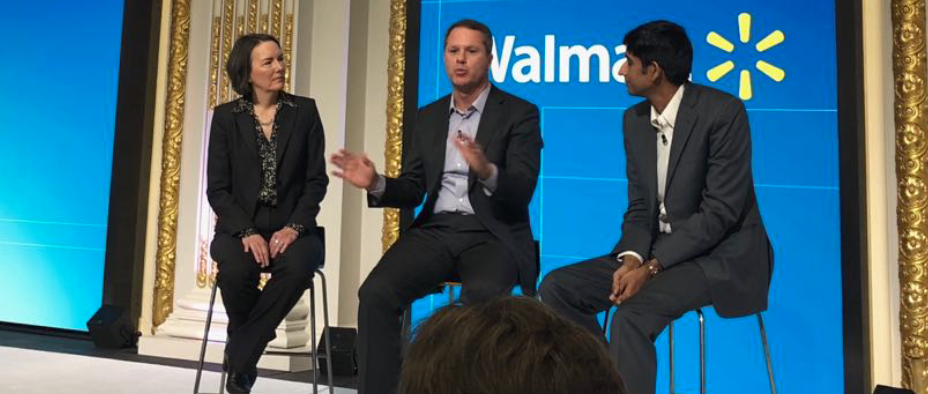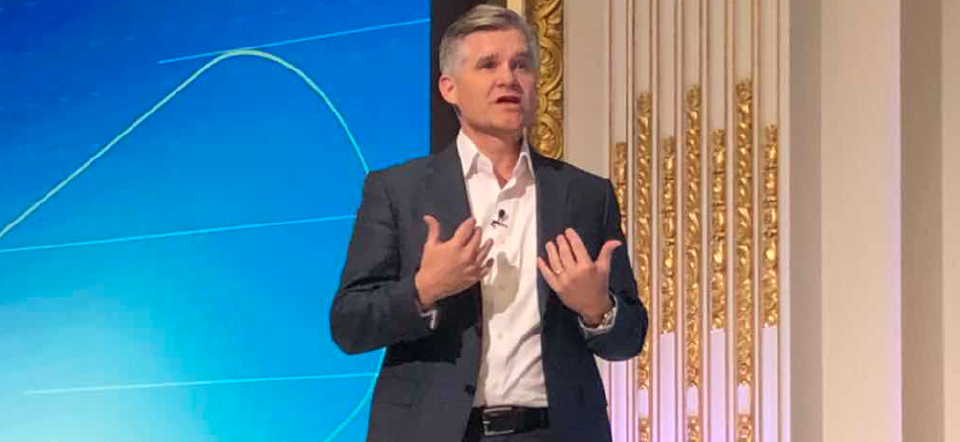
albert Chan
The Coresight Research team attended Walmart’s 2020 Investor Community Meeting on February 18 at the New York Stock Exchange.
These are the highlights of the event:
Management Is Focused on Providing the Best Omnichannel Experience
Walmart is changing to adapt to people’s increasingly omnichannel shopping habits. Company data shows that customers who shop both in store and online spend twice as much as customers who shop in store only—and, they spend more in store, as well. The company will continue to add assortment and new brands to its online offering, and look for ways to accelerate the supply chain. Walmart has already made several assortment acquisitions, including shoes.com, art.com and Hayneedle, which have added category volume and expertise. Sam’s Club China is also creating new store formats to tailor to local tastes. Around 30% of Sam’s Club members shop both online and offline.
Walmart plans partnerships in the digital entertainment space.
Walmart has also launched two customer apps, which it refers to internally as the “blue app” and the “orange app.” The blue app is the traditional Walmart direct-to-home e-commerce app, while the orange app is dedicated to grocery. The two apps let customers shop for products in specific channels, while Walmart can leverage the traffic from one app by directing customers to the other to increase total traffic.
[caption id="attachment_103985" align="aligncenter" width="700"] Walmart’s partnership/joint venture ecosystem
Walmart’s partnership/joint venture ecosystem
Source: Company reports[/caption] Walmart’s Expense Leverage Is Sustainable and Cost Culture Is Strong The Walmart US stores team has leveraged expenses (lowered costs as a percentage of sales) for the last 12 quarters. Investments in training and technology are improving sales and operating efficiency. Management remains committed to reducing the company’s expense rate even further. For example, Walmart says it can shave 15% off the cost of an associate’s vest—which are (as an added bonus) also made from recycled material. In Mexico, the company has cut 15% from transport and supply costs, saving some $300 million. Walmart Will Improve the Pickup Experience and Build on That Capability To Scale Delivery Walmart started providing same-day delivery in early 2018, and it’s now available from more than 1,600 stores reaching more than 50% of the US population. In September 2018, Walmart announced the launch of Spark Delivery, a Walmart-conceived service that crowdsources independent drivers to fulfill last-mile delivery. In June 2019, Walmart launched Delivery Unlimited in the US, which lets customers pay $98 per year or $12.95 per month for unlimited Walmart online grocery order delivery, instead of a flat fee for each order. Shoppers still have the option of paying per-delivery. In China, Walmart’s e-commerce business grew 95% in 2019 as the company expanded Walmart Daojia and JD Dojia, two delivery programs that can cut delivery time to 40 minutes. In Mexico, Walmart also offers same-day delivery for grocery products, consumables and thousands of general merchandise items. The company is building its e-commerce and omnichannel experiences in Mexico. The company opened 134 new stores in Mexico in 2019, bringing the total number of stores operated by Walmart de México y Centroamérica (which includes Mexico and Central American countries) to more than 3,400. [caption id="attachment_103986" align="aligncenter" width="700"] Kath McLay, President and CEO of Sam’s Club
Kath McLay, President and CEO of Sam’s Club
Source: Coresight Research[/caption] Sam’s Club Has Become an Innovation Hub Walmart has also improved associate education, and retention has improved. Associates are better equipped with apps on mobile devices that help streamline work and put information at their fingertips. Automation in stores is helping the company improve operational efficiency. Sam's Club provides a good example of the benefits of automation: It has become an innovation hub in the company, leveraging technologies such as scan and go, self-scanning robots and voice-driven tools. One example is Membership Express, an innovation that lets customers sign up as new members in less than a minute. New apps such as Sam's Garage let members to buy tires more quickly. And, the Ask Sam voice app helps associates more quickly find answers. “It runs on voice, and voice is a big idea, not only for associates, but also to customers,” said John Furner, Walmart US President and CEO. All these technologies have proved effective in driving sales. Sam’s Club has seen 16 consecutive quarters of comp sales growth, excluding fuel. Plus, renewals and new sign-ups pushed up membership 2.5% for the full year 2019. Healthcare Is Another Big Opportunity Walmart sees opportunity in healthcare, and has already opened two Walmart health clinics in Georgia. Walmart is now exploring ways to add digital capabilities that extend outside the clinics, and connect that to online buying to complete the experience. CEO John Furner said it will take time to scale and update its healthcare businesses, but Walmart believes it is the right strategy to equip traditional physical businesses with new digital capabilities, and further enhance the omnichannel experience. [caption id="attachment_103987" align="aligncenter" width="700"] Walmart US President and CEO John Furner talks about the opportunity in healthcare
Walmart US President and CEO John Furner talks about the opportunity in healthcare
Source: Coresight Research[/caption] In India, Flipkart and PhonePe Are Scaling Quickly to Help Walmart Grow in Advertising and Financial Services Flipkart and PhonePe are helping Walmart create an open technology ecosystem for customers, merchants and banks. In May 2018, Walmart bought a 77% stake in India's top e-commerce firm Flipkart, valued at $21 billion. Flipkart has continued to use data and insights to find new revenue streams, for example, digital advertising, which grew strongly year-on-year. Flipkart-owned PhonePe has grown to be one of India’s leading digital payment companies, and its volume and value of transactions have increased over the past year as consumers embrace the technology to transfer money to businesses for products and services. The business is just three years old but it has grown to almost 200,000 registered users. Now, Walmart owns these two entities, boosting its presence in financial services. For example, with the PhonePe ATM product, customers can use their phones to get cash back the way people in the US can when paying with an ATM card. The customer transfers the money from a connected bank account, then the merchant verifies the transaction and gives the customer cash, and is paid through the app. The service is available in over one million stores. More than 65% of the nearly 200 million PhonePe users are from small towns and villages—who may otherwise not have ready access to modern banking services. Walmart says this is testament to the power of technology to democratize access to financial services. Walmart is also working with about 10 million merchants, mostly small and medium enterprises, seeking to drive growth by connecting them to Walmart’s consumer network. [caption id="attachment_103988" align="aligncenter" width="700"] Walmart management discuss PhonePe, from left to right: Kathleen McLaughlin, Chief Sustainability Officer; Doug McMillon, President and CEO; Karthik Raghupathi, Head of Strategic Development and Business Development for PhonePe
Walmart management discuss PhonePe, from left to right: Kathleen McLaughlin, Chief Sustainability Officer; Doug McMillon, President and CEO; Karthik Raghupathi, Head of Strategic Development and Business Development for PhonePe
Source: Coresight Research[/caption] Fiscal 4Q20 and FY20 Results Walmart reported fiscal 4Q20 revenues of $141.7 billion, up 2.1% year over year but missing the consensus estimate of $142.7 billion, due to soft sales in toys, media and gaming, and apparel. The company performed well in electronics, Christmas seasonal, the home categories and health and wellness. Adjusted EPS was $1.38, missing the consensus estimate of $1.44. Walmart US online sales increased 35%, benefiting from strong growth in grocery pickup and delivery. US comps increased 1.9% (equating to 6.0% on a two-year stacked basis) with continued strength in food and consumables. International sales increased 2.2% in the quarter, with strength in Mexico, China and India, offset by unrest in Chile and some continuing challenges in the UK and Canada. Walmart now operates more than 6,000 stores in 26 countries. Total FY20 revenues were $524.0 billion, up 1.9% year over year. US comps increased 2.8%. US online sales increased 37%. International sales increased a solid 2.8% in constant currency. Sam's Club membership trends contributed to operating income growth of 8% for the year. Adjusted EPS was $4.93. Management Expects Sales Growth Momentum To Continue in 2021 Walmart provided FY21 guidance as follows: Brett Biggs, Walmart Executive Vice President and CFO
Brett Biggs, Walmart Executive Vice President and CFO
Source: Coresight Research[/caption]
 Walmart’s partnership/joint venture ecosystem
Walmart’s partnership/joint venture ecosystemSource: Company reports[/caption] Walmart’s Expense Leverage Is Sustainable and Cost Culture Is Strong The Walmart US stores team has leveraged expenses (lowered costs as a percentage of sales) for the last 12 quarters. Investments in training and technology are improving sales and operating efficiency. Management remains committed to reducing the company’s expense rate even further. For example, Walmart says it can shave 15% off the cost of an associate’s vest—which are (as an added bonus) also made from recycled material. In Mexico, the company has cut 15% from transport and supply costs, saving some $300 million. Walmart Will Improve the Pickup Experience and Build on That Capability To Scale Delivery Walmart started providing same-day delivery in early 2018, and it’s now available from more than 1,600 stores reaching more than 50% of the US population. In September 2018, Walmart announced the launch of Spark Delivery, a Walmart-conceived service that crowdsources independent drivers to fulfill last-mile delivery. In June 2019, Walmart launched Delivery Unlimited in the US, which lets customers pay $98 per year or $12.95 per month for unlimited Walmart online grocery order delivery, instead of a flat fee for each order. Shoppers still have the option of paying per-delivery. In China, Walmart’s e-commerce business grew 95% in 2019 as the company expanded Walmart Daojia and JD Dojia, two delivery programs that can cut delivery time to 40 minutes. In Mexico, Walmart also offers same-day delivery for grocery products, consumables and thousands of general merchandise items. The company is building its e-commerce and omnichannel experiences in Mexico. The company opened 134 new stores in Mexico in 2019, bringing the total number of stores operated by Walmart de México y Centroamérica (which includes Mexico and Central American countries) to more than 3,400. [caption id="attachment_103986" align="aligncenter" width="700"]
 Kath McLay, President and CEO of Sam’s Club
Kath McLay, President and CEO of Sam’s ClubSource: Coresight Research[/caption] Sam’s Club Has Become an Innovation Hub Walmart has also improved associate education, and retention has improved. Associates are better equipped with apps on mobile devices that help streamline work and put information at their fingertips. Automation in stores is helping the company improve operational efficiency. Sam's Club provides a good example of the benefits of automation: It has become an innovation hub in the company, leveraging technologies such as scan and go, self-scanning robots and voice-driven tools. One example is Membership Express, an innovation that lets customers sign up as new members in less than a minute. New apps such as Sam's Garage let members to buy tires more quickly. And, the Ask Sam voice app helps associates more quickly find answers. “It runs on voice, and voice is a big idea, not only for associates, but also to customers,” said John Furner, Walmart US President and CEO. All these technologies have proved effective in driving sales. Sam’s Club has seen 16 consecutive quarters of comp sales growth, excluding fuel. Plus, renewals and new sign-ups pushed up membership 2.5% for the full year 2019. Healthcare Is Another Big Opportunity Walmart sees opportunity in healthcare, and has already opened two Walmart health clinics in Georgia. Walmart is now exploring ways to add digital capabilities that extend outside the clinics, and connect that to online buying to complete the experience. CEO John Furner said it will take time to scale and update its healthcare businesses, but Walmart believes it is the right strategy to equip traditional physical businesses with new digital capabilities, and further enhance the omnichannel experience. [caption id="attachment_103987" align="aligncenter" width="700"]
 Walmart US President and CEO John Furner talks about the opportunity in healthcare
Walmart US President and CEO John Furner talks about the opportunity in healthcareSource: Coresight Research[/caption] In India, Flipkart and PhonePe Are Scaling Quickly to Help Walmart Grow in Advertising and Financial Services Flipkart and PhonePe are helping Walmart create an open technology ecosystem for customers, merchants and banks. In May 2018, Walmart bought a 77% stake in India's top e-commerce firm Flipkart, valued at $21 billion. Flipkart has continued to use data and insights to find new revenue streams, for example, digital advertising, which grew strongly year-on-year. Flipkart-owned PhonePe has grown to be one of India’s leading digital payment companies, and its volume and value of transactions have increased over the past year as consumers embrace the technology to transfer money to businesses for products and services. The business is just three years old but it has grown to almost 200,000 registered users. Now, Walmart owns these two entities, boosting its presence in financial services. For example, with the PhonePe ATM product, customers can use their phones to get cash back the way people in the US can when paying with an ATM card. The customer transfers the money from a connected bank account, then the merchant verifies the transaction and gives the customer cash, and is paid through the app. The service is available in over one million stores. More than 65% of the nearly 200 million PhonePe users are from small towns and villages—who may otherwise not have ready access to modern banking services. Walmart says this is testament to the power of technology to democratize access to financial services. Walmart is also working with about 10 million merchants, mostly small and medium enterprises, seeking to drive growth by connecting them to Walmart’s consumer network. [caption id="attachment_103988" align="aligncenter" width="700"]
 Walmart management discuss PhonePe, from left to right: Kathleen McLaughlin, Chief Sustainability Officer; Doug McMillon, President and CEO; Karthik Raghupathi, Head of Strategic Development and Business Development for PhonePe
Walmart management discuss PhonePe, from left to right: Kathleen McLaughlin, Chief Sustainability Officer; Doug McMillon, President and CEO; Karthik Raghupathi, Head of Strategic Development and Business Development for PhonePeSource: Coresight Research[/caption] Fiscal 4Q20 and FY20 Results Walmart reported fiscal 4Q20 revenues of $141.7 billion, up 2.1% year over year but missing the consensus estimate of $142.7 billion, due to soft sales in toys, media and gaming, and apparel. The company performed well in electronics, Christmas seasonal, the home categories and health and wellness. Adjusted EPS was $1.38, missing the consensus estimate of $1.44. Walmart US online sales increased 35%, benefiting from strong growth in grocery pickup and delivery. US comps increased 1.9% (equating to 6.0% on a two-year stacked basis) with continued strength in food and consumables. International sales increased 2.2% in the quarter, with strength in Mexico, China and India, offset by unrest in Chile and some continuing challenges in the UK and Canada. Walmart now operates more than 6,000 stores in 26 countries. Total FY20 revenues were $524.0 billion, up 1.9% year over year. US comps increased 2.8%. US online sales increased 37%. International sales increased a solid 2.8% in constant currency. Sam's Club membership trends contributed to operating income growth of 8% for the year. Adjusted EPS was $4.93. Management Expects Sales Growth Momentum To Continue in 2021 Walmart provided FY21 guidance as follows:
- Net sales growth of around 3% in constant currency.
- US Walmart comps to grow at least 2.5%, excluding fuel; and, Sam’s Club comps to grow at least 3%, excluding fuel and tobacco.
- Walmart US e-commerce growth of around 30%.
- Adjusted EPS of $5.00 to $5.15, up by between 1.5% and 4.5%.
- Capital expenditures of around $11 billion.
 Brett Biggs, Walmart Executive Vice President and CFO
Brett Biggs, Walmart Executive Vice President and CFOSource: Coresight Research[/caption]